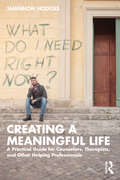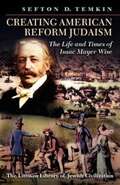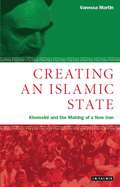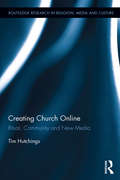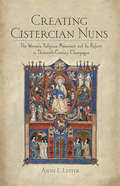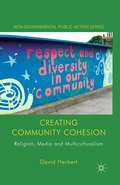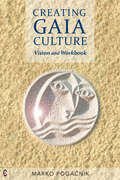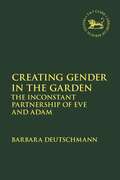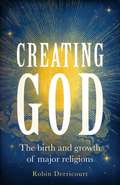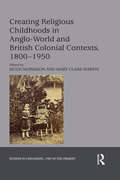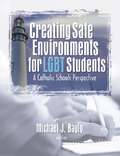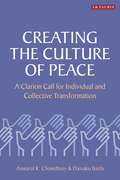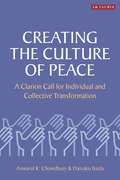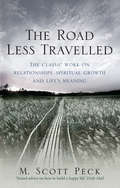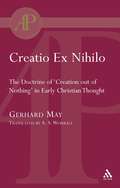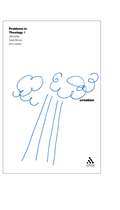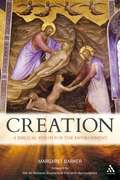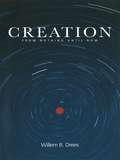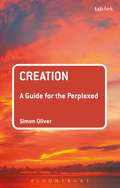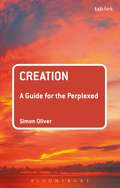- Table View
- List View
Creating a Meaningful Life: A Practical Guide for Counselors, Therapists, and Other Helping Professionals
by Shannon HodgesCreating a Meaningful Life builds on the tenets of mindfulness-based cognitive therapy (MBCT) to answer some of life’s basic questions, such as "How do I create a meaningful, purposeful life?" and "Is the life I am living one that brings me fulfillment, purpose, and a sense of inner peace?" Using a variety of techniques, including journaling, grounding exercises, cognitive self-talk restructuring, and more, chapters invite counseling professionals and students to explore their inner landscape, better understand themselves and find communion with others.
Creating American Reform Judaism: The Life and Times of Isaac Mayer Wise (The Littman Library of Jewish Civilization)
by Sefton D. TemkinIsaac Mayer Wise (1819–1900), founder of the major institutions of Reform Judaism in America, was a man of his time—a pioneer in a pioneer’s world. When he came to America from his childhood Bohemia in 1846, he found fewer than 50,000 Jews and only two ordained rabbis. With his sense of mission and tireless energy, he set himself to tailoring the vehicle of Reform Judaism to meet the needs of the growing Jewish community. Wise strove for unity among American Jews, and for a college to train rabbis to serve them. The establishment of Hebrew Union College (1875) was the crowning achievement of his life. His quest for unity also led him to draw up an American Jewish prayer-book, Minhag America, to found the Central Conference of American Rabbis, and to edit two weeklies; their editorials, breathing fire and energy, were no less important in his quest for leadership. Here as elsewhere, it was his persistence that won him the war where his impetuosity lost him many battles. Professor Temkin’s writing captures the vigour of Wise’s personality and the politics and concerns of contemporary Jewish life and leadership in America. Based primarily on material in the American Jewish Archives of the Hebrew Union College, this biography is a lively portrait of a rabbi whose singular efforts in many fields made him a pivotal figure in the naturalization of the Jew and Judaism in the New World. The book was first published in hardback in 1992 under the title Isaac Mayer Wise: Shaping American Judaism.
Creating an Islamic State: Khomeini and the Making of a New Iran (Library of Modern Middle East Studies)
by Vanessa MartinHow did the Ayatollah Khomeini create his Islamic state? What were the ideas which drove him and his movement? What organisation and methods helped bring him to power?This extraordinary book is the first to analyse the ideological roots of an Islamic state as conceived by the Ayatollah Khomeini. Surprisingly the author finds much of the inspiration behind Khomeini's political thinking being influenced by western sources – his writings on the supreme Islamic Jurist being affected by Plato's notions of the philosopher-king and his views of state power and centralism being closely linked to his understanding of Marxist/Leninist totalitarianism. Vanessa Martin makes a groundbreaking contribution on the dynamics of the Iranian Revolution and the Islamist revival especially relevant in the context of the debated arising out of Irans' recent elections.
Creating Church Online: Ritual, Community and New Media (Routledge Research in Religion, Media and Culture)
by Tim HutchingsOnline churches are internet-based Christian communities, pursuing worship, discussion, friendship, support, proselytization, and other key religious goals through computer-mediated communication. Hundreds of thousands of people are now involved with online congregations, generating new kinds of ritual, leadership, and community and new networks of global influence. Creating Church Online constructs a rich ethnographic account of the diverse cultures of online churches, from virtual worlds to video streams. This book also outlines the history of online churchgoing, from its origins in the 1980s to the present day, and traces the major themes of academic and Christian debate around this topic. Applying some of the leading current theories in the study of religion, media and culture to this data, Tim Hutchings proposes a new model of religious design in contexts of mediatization, and draws attention to digital networks, transformative third spaces and terrains of existential vulnerability. Creating Church Online advances our understanding of the significance and impact of digital media in the religious and social lives of its users, in search of new theoretical frameworks for digital religion.
Creating Church Online: Ritual, Community and New Media (Routledge Research in Religion, Media and Culture)
by Tim HutchingsOnline churches are internet-based Christian communities, pursuing worship, discussion, friendship, support, proselytization, and other key religious goals through computer-mediated communication. Hundreds of thousands of people are now involved with online congregations, generating new kinds of ritual, leadership, and community and new networks of global influence. Creating Church Online constructs a rich ethnographic account of the diverse cultures of online churches, from virtual worlds to video streams. This book also outlines the history of online churchgoing, from its origins in the 1980s to the present day, and traces the major themes of academic and Christian debate around this topic. Applying some of the leading current theories in the study of religion, media and culture to this data, Tim Hutchings proposes a new model of religious design in contexts of mediatization, and draws attention to digital networks, transformative third spaces and terrains of existential vulnerability. Creating Church Online advances our understanding of the significance and impact of digital media in the religious and social lives of its users, in search of new theoretical frameworks for digital religion.
Creating Cistercian Nuns: The Women's Religious Movement and Its Reform in Thirteenth-Century Champagne
by Anne E. LesterIn Creating Cistercian Nuns, Anne E. Lester addresses a central issue in the history of the medieval church: the role of women in the rise of the religious reform movement of the thirteenth century. Focusing on the county of Champagne in France, Lester reconstructs the history of the women’s religious movement and its institutionalization within the Cistercian order.The common picture of the early Cistercian order is that it was unreceptive to religious women. Male Cistercian leaders often avoided institutional oversight of communities of nuns, preferring instead to cultivate informal relationships of spiritual advice and guidance with religious women. As a result, scholars believed that women who wished to live a life of service and poverty were more likely to join one of the other reforming orders rather than the Cistercians. As Lester shows, however, this picture is deeply flawed. Between 1220 and 1240 the Cistercian order incorporated small independent communities of religious women in unprecedented numbers. Moreover, the order not only accommodated women but also responded to their interpretations of apostolic piety, even as it defined and determined what constituted Cistercian nuns in terms of dress, privileges, and liturgical practice. Lester reconstructs the lived experiences of these women, integrating their ideals and practices into the broader religious and social developments of the thirteenth century—including the crusade movement, penitential piety, the care of lepers, and the reform agenda of the Fourth Lateran Council. The book closes by addressing the reasons for the subsequent decline of Cistercian convents in the fourteenth century. Based on extensive analysis of unpublished archives, Creating Cistercian Nuns will force scholars to revise their understanding of the women’s religious movement as it unfolded during the thirteenth century.
Creating Community Cohesion: Religion, Media and Multiculturalism (Non-Governmental Public Action)
by D. HerbertUsing approaches from sociology, media and religious studies, David Herbert compares recent public controversies involving or implicating religion in the UK (England and Northern Ireland), the Netherlands and France.
Creating Gaia Culture: Vision and Workbook
by Marko PogačnikHumanity stands at the threshold of a new phase of Earth’s planetary evolution. Breathtaking possibilities – in tune with the evolutionary path of the universe – are now available. Yet the question arises: Does humanity have the ideas, foresight and potential for action that could create a culture that corresponds to the planet’s transformation?In the midst of distressing ecological crises, Marko Pogačnik offers fresh hope. Having worked intensively in the fields of holistic ecology (geomancy) and Earth-healing for four decades, he now formulates a vision of a culture based on co-creation with Gaia (the Earth), her elemental worlds and beings from parallel evolutions. Creating Gaia Culture is also a workbook, featuring dozens of drawings and meditative exercises to help transcend mental obstacles by cultivating the quality of living imagination.Pogačnik – UNO Goodwill Ambassador and UNESCO Artist for Peace – presents numerous ways to collaborate with the process of creating Gaia culture. He allows us to look into the primeval source of the future by interpreting the ancient book of the biblical Apocalypse – a text that holds the secret of Earth changes in a coded vision of a new human civilization – and uses his experiences, visions, dream stories and communications with beings from parallel worlds to trigger pictures that can enable a new human culture become a tactile reality.‘The only path that makes sense is to reconnect with the essence of life and embrace a loving partnership with Gaia, Earth. This path involves a challenging transformation of our current cultures and may provoke changes in many aspects of the embodied world as we know it, as we continue to evolve into the future.’
Creating Gender in the Garden: The Inconstant Partnership of Eve and Adam (The Library of Hebrew Bible/Old Testament Studies)
by Barbara DeutschmannWhat can explain the persistence of gender inequality throughout history? Do narratives such as the Eden story explain that dissymmetry or contribute to it? This book suggests that the Hebrew Bible began and has sustained a rich conversation about sex and gender throughout its life. A literary study of the Garden of Eden story reveals a focus on the human partnership as integral to the divine creation project. Texts from other Hebrew Bible genres build a picture of robust and flexible partnerships within a patriarchal framework.In popular culture, Eve still carries the stench of guilt while Adam, seemingly unscathed by Eden events, remains a positive symbol of manhood. This book helps explain why they have had such different histories. The book also charts the subversive alternate streams of interpretation of women's writings and rabbinic texts.The story of Adam and Eve demonstrates how conceptions of gender in both ancient and modern worlds reflect larger philosophical schemes. Far from existing as timeless verities, female and male relations are constructed according to cultural imperatives of the day. Understanding the different ways that Adam and Eve have been conceived gives us perspective on our own twenty-first century gender architecture.
Creating God: The birth and growth of major religions
by Robin DerricourtWhat do we really know about how and where religions began, and how they spread? In this bold new book, award-winning author Robin Derricourt takes us on a journey through the birth and growth of several major religions, using history and archaeology to recreate the times, places and societies that witnessed the rise of significant monotheistic faiths. Beginning with Mormonism and working backwards through Islam, Christianity and Judaism to Zoroastrianism, Creating God opens up the conditions that allowed religious movements to emerge, attract their first followers and grow. Throughout history there have been many prophets: individuals who believed they were in direct contact with the divine, with instructions to spread a religious message. While many disappeared without trace, some gained millions of followers and established a lasting religion. In Creating God, Robin Derricourt has produced a brilliant, panoramic book that offers new insights on the origins of major religions and raises essential questions about why some succeeded where others failed.
Creating God: The birth and growth of major religions (G - Reference,information And Interdisciplinary Subjects Ser.)
by Robin DerricourtWhat do we really know about how and where religions began, and how they spread? In this bold new book, award-winning author Robin Derricourt takes us on a journey through the birth and growth of several major religions, using history and archaeology to recreate the times, places and societies that witnessed the rise of significant monotheistic faiths. Beginning with Mormonism and working backwards through Islam, Christianity and Judaism to Zoroastrianism, Creating God opens up the conditions that allowed religious movements to emerge, attract their first followers and grow. Throughout history there have been many prophets: individuals who believed they were in direct contact with the divine, with instructions to spread a religious message. While many disappeared without trace, some gained millions of followers and established a lasting religion. In Creating God, Robin Derricourt has produced a brilliant, panoramic book that offers new insights on the origins of major religions and raises essential questions about why some succeeded where others failed.
Creating Religious Childhoods in Anglo-World and British Colonial Contexts, 1800-1950 (Studies in Childhood, 1700 to the Present)
by Hugh Morrison Mary Clare MartinDrawing on examples from British world expressions of Christianity, this collection further greater understanding of religion as a critical element of modern children’s and young people’s history. It builds on emerging scholarship that challenges the view that religion had a solely negative impact on nineteenth- and twentieth-century children, or that ‘secularization’ is the only lens to apply to childhood and religion. Putting forth the argument that religion was an abiding influence among British world children throughout the nineteenth and most of the twentieth centuries, this volume places ‘religion’ at the center of analysis and discussion. At the same time, it positions the religious factor within a broader social and cultural framework. The essays focus on the historical contexts in which religion was formative for children in various ‘British’ settings denoted as ‘Anglo’ or ‘colonial’ during the nineteenth and early- to mid-twentieth centuries. These contexts include mission fields, churches, families, Sunday schools, camps, schools and youth movements. Together they are treated as ‘sites’ in which religion contributed to identity formation, albeit in different ways relating to such factors as gender, race, disability and denomination. The contributors develop this subject for childhoods that were experienced largely, but not exclusively, outside the ‘metropole’, in a diversity of geographical settings. By extending the geographic range, even within the British world, it provides a more rounded perspective on children’s global engagement with religion.
Creating Religious Childhoods in Anglo-World and British Colonial Contexts, 1800-1950 (Studies in Childhood, 1700 to the Present)
by Hugh Morrison Mary Clare MartinDrawing on examples from British world expressions of Christianity, this collection further greater understanding of religion as a critical element of modern children’s and young people’s history. It builds on emerging scholarship that challenges the view that religion had a solely negative impact on nineteenth- and twentieth-century children, or that ‘secularization’ is the only lens to apply to childhood and religion. Putting forth the argument that religion was an abiding influence among British world children throughout the nineteenth and most of the twentieth centuries, this volume places ‘religion’ at the center of analysis and discussion. At the same time, it positions the religious factor within a broader social and cultural framework. The essays focus on the historical contexts in which religion was formative for children in various ‘British’ settings denoted as ‘Anglo’ or ‘colonial’ during the nineteenth and early- to mid-twentieth centuries. These contexts include mission fields, churches, families, Sunday schools, camps, schools and youth movements. Together they are treated as ‘sites’ in which religion contributed to identity formation, albeit in different ways relating to such factors as gender, race, disability and denomination. The contributors develop this subject for childhoods that were experienced largely, but not exclusively, outside the ‘metropole’, in a diversity of geographical settings. By extending the geographic range, even within the British world, it provides a more rounded perspective on children’s global engagement with religion.
Creating Safe Environments for LGBT Students: A Catholic Schools Perspective
by Michael J. BaylyMake sure your Catholic school's LGBT students are getting the support they need Creating Safe Environments for LGBT Students is a comprehensive training guidebook for educators who are committed to diversity and the full inclusion of LGBT students in every aspect of the Catholic high school experience. Based on five years of pilot testing in Catholic schools, this unique book emphasizes safe-staff training in integrating the Church's pastoral, social, and moral dimensions with the special needs of LGBT students. The book presents strategies and resources for building safer schools, helpful materials for communicating with parents, and general guidelines for developing and maintaining professional helping relationships with LGBT students. Based on a "training the trainer" model, Creating Safe Environments for LGBT Students encourages the development of grassroots leadership within the school. This unique book promotes a positive framework for navigating the challenging landscape of the Catholic tradition and the LGBT experience as it helps to establish anti-harassment and anti-bullying protocols for school environments and models for developing LGBT student support groups and gay/straight student alliances. The book promotes role-play by students, alumni, teachers, and parents-a hallmark of the ministry work and training methods of the Catholic Pastoral Committee on Sexual Minorities-and is flexible enough to allow each school's individual climate and culture to be respected.Creating Safe Environments for LGBT Students includes:* first-hand stories from students and teachers* realistic, dynamic, and creative role-play scenarios that explore various relationships between students, teachers, parents, administrators, and the school board* opening prayer and meditation rituals* a special foreword by Bishop Thomas J. Gumbleton, one of the few Catholic bishops to publicly affirm LGBT persons* an extensive bibliography and glossary regarding the experiences, language, culture, and spirituality of LGBT youth* the latest research findings on at-risk behaviors of LGBT teenagers * training handouts that are easy to duplicate and use as transparencies* a manual log that can be used as a training diary* and much more!Creating Safe Environments for LGBT Students is an essential resource for faculty and staff members at Catholic high schools, particularly school administrators, chaplains, campus ministers, psychologists, social workers, and counselors.
Creating Safe Environments for LGBT Students: A Catholic Schools Perspective
by Michael J. BaylyMake sure your Catholic school's LGBT students are getting the support they need Creating Safe Environments for LGBT Students is a comprehensive training guidebook for educators who are committed to diversity and the full inclusion of LGBT students in every aspect of the Catholic high school experience. Based on five years of pilot testing in Catholic schools, this unique book emphasizes safe-staff training in integrating the Church's pastoral, social, and moral dimensions with the special needs of LGBT students. The book presents strategies and resources for building safer schools, helpful materials for communicating with parents, and general guidelines for developing and maintaining professional helping relationships with LGBT students. Based on a "training the trainer" model, Creating Safe Environments for LGBT Students encourages the development of grassroots leadership within the school. This unique book promotes a positive framework for navigating the challenging landscape of the Catholic tradition and the LGBT experience as it helps to establish anti-harassment and anti-bullying protocols for school environments and models for developing LGBT student support groups and gay/straight student alliances. The book promotes role-play by students, alumni, teachers, and parents-a hallmark of the ministry work and training methods of the Catholic Pastoral Committee on Sexual Minorities-and is flexible enough to allow each school's individual climate and culture to be respected.Creating Safe Environments for LGBT Students includes:* first-hand stories from students and teachers* realistic, dynamic, and creative role-play scenarios that explore various relationships between students, teachers, parents, administrators, and the school board* opening prayer and meditation rituals* a special foreword by Bishop Thomas J. Gumbleton, one of the few Catholic bishops to publicly affirm LGBT persons* an extensive bibliography and glossary regarding the experiences, language, culture, and spirituality of LGBT youth* the latest research findings on at-risk behaviors of LGBT teenagers * training handouts that are easy to duplicate and use as transparencies* a manual log that can be used as a training diary* and much more!Creating Safe Environments for LGBT Students is an essential resource for faculty and staff members at Catholic high schools, particularly school administrators, chaplains, campus ministers, psychologists, social workers, and counselors.
Creating the Culture of Peace: A Clarion Call for Individual and Collective Transformation
by Anwarul K. Chowdhury Daisaku IkedaThe culture of peace and non-violence is essential to human existence, development and progress. In 1999, the United Nations General Assembly adopted by consensus the norm-setting, forward-looking “Declaration and Programme of Action on a Culture of Peace”. Governments, institutions, NGOs, other civil society entities and, in particular, individuals – all are encouraged therein to contribute to the global movement for the culture of peace.Related to this vision, this rich and varied dialogue discusses how the culture of peace can be achieved in the world. Based on the extensive personal and professional experiences of two high-profile thinkers and activists, they analyse the challenges unfolding at local, national and global levels and how these relate to humanity's quest for peace, human security and happiness. Although coming from very different positions – one a Buddhist philosopher, educator and leader; the other a UN diplomat renowned for his international work in peace, development and human rights – these interlocutors are united in their search for justice and better quality of life for all and their conviction that women and young people are the most effective means to achieving positive change in the world.The dialogue provides ideas on the key challenges that face our planet: poverty and deprivation, war and violence, nuclear weapons and small arms, climate change and environmental degradation, weak governance and financial crises, marginalization of women and alienation of youth and the relentless drive for materialism. They also invite us to consider how the culture of peace can be practically achieved through an individual, collective and institutional transformation.Recognizing that global citizenship, multilateralism, women's equality and value-creating education are central and inter-linked themes, this dialogue also underscores the inherent strength of spirituality, compassion, empathy, forgiveness, respect for diversity and empowerment that comes from the trials and tribulations of life.
Creating the Culture of Peace: A Clarion Call for Individual and Collective Transformation
by Anwarul K. Chowdhury Daisaku IkedaThe culture of peace and non-violence is essential to human existence, development and progress. In 1999, the United Nations General Assembly adopted by consensus the norm-setting, forward-looking “Declaration and Programme of Action on a Culture of Peace”. Governments, institutions, NGOs, other civil society entities and, in particular, individuals – all are encouraged therein to contribute to the global movement for the culture of peace.Related to this vision, this rich and varied dialogue discusses how the culture of peace can be achieved in the world. Based on the extensive personal and professional experiences of two high-profile thinkers and activists, they analyse the challenges unfolding at local, national and global levels and how these relate to humanity's quest for peace, human security and happiness. Although coming from very different positions – one a Buddhist philosopher, educator and leader; the other a UN diplomat renowned for his international work in peace, development and human rights – these interlocutors are united in their search for justice and better quality of life for all and their conviction that women and young people are the most effective means to achieving positive change in the world.The dialogue provides ideas on the key challenges that face our planet: poverty and deprivation, war and violence, nuclear weapons and small arms, climate change and environmental degradation, weak governance and financial crises, marginalization of women and alienation of youth and the relentless drive for materialism. They also invite us to consider how the culture of peace can be practically achieved through an individual, collective and institutional transformation.Recognizing that global citizenship, multilateralism, women's equality and value-creating education are central and inter-linked themes, this dialogue also underscores the inherent strength of spirituality, compassion, empathy, forgiveness, respect for diversity and empowerment that comes from the trials and tribulations of life.
Creating True Peace: Ending Conflict in Yourself, Your Community and the World
by Thich Nhat HanhThich Nhat Hanh has been the world's foremost peace activist for the past four decades. A highly respected Buddhist spiritual leader who is also a philosopher, scholar and student of human nature, he is, in many ways, very similar to the Dalai Lama. His unrivalled knowledge, wisdom and experience of peacemaking - a subject that he has very much made his own ever since he took a non-violent stance on the Vietnam War - make him the perfect candidate to talk authoritatively on this very topical subject. Creating True Peace is his most definitive book on peacemaking to date. In this remarkable manifesto he shows conflict to be an inappropriate response that we can no longer afford on a personal or global level. He also offers practical - previously unpublished - spiritual training for individual and world peace which reveals the powerful daily actions and interactions that can root out conflict from us all. 'Thich Nhat Hanh shows us the connection between personal, inner peace and peace on earth' Dalai Lama'Among Buddhist leaders influential in the West, Thich Nhat Hanh ranks second only to the Dalai Lama' New York Times
Creatio Ex Nihilo: Creatio Ex Nihilo
by Gerhard MayA unique study challenging the assumption that the doctrine of 'creation out of nothing' was inherited by Christianity along with the Jewish scriptures which the Church adopted.
Creation (Problems in Theology)
by Jeff Astley David Brown Ann LoadesThis reader brings together modern material from a wide range of Christian theologians on the meaning and status of the doctrine of creation; its relation to scientific theories, our understanding of God and the theology of redemption; and its implications for our proper attitude to the world of Nature.Process theology, the Gaia hypothesis, New Age spirituality, and pantheism are among the range of topics that are introduced and critiqued.Contributors include Carol Adams, Karl Barth, Teilhard de Chardin, Celia Deane-Drummond, Colin Gunton, Jurgen Moltmann, Schubert Ogden, John Polkinghorne.
Creation: A Biblical Vision for the Environment
by Margaret BarkerMargaret Barker contributes a characteristically Christian voice to contemporary theological debates on the environment. Most of the issues we face today were not those that faced the early Christian community and so there are often no directly relevant biblical teachings. Barker's starting point is the question of what Jesus himself would have believed about the Creation? What could the early Church have believed about the Creation? She then shows how much of this belief is embedded, often unrecognised, in the New Testament and early Christian texts. It was what people assumed as the norm, the worldview within which they lived and expressed their faith. Barker establishes the general principles of a Christian view of Creation. Some of what she says will show how current teaching would have been unfamiliar to the first Christians, not just in application but in basic principles.
Creation: From Nothing Until Now
by Willem B. DreesWhere do we come from? Where are we going? These are fundamental questions, which the human race has asked itself for centuries.Presenting a brief and accessible overview of contemporary scientific thought, Creation is an imaginative and poetic exploration of the origins of the universe. WIllem Drees assesses the religious and philosophical impact of scientific theories of evolution and the natural world, and examines the changing relationship between us and our planet.
Creation: From Nothing Until Now
by Willem B. DreesWhere do we come from? Where are we going? These are fundamental questions, which the human race has asked itself for centuries.Presenting a brief and accessible overview of contemporary scientific thought, Creation is an imaginative and poetic exploration of the origins of the universe. WIllem Drees assesses the religious and philosophical impact of scientific theories of evolution and the natural world, and examines the changing relationship between us and our planet.
Creation: A Guide for the Perplexed (Guides for the Perplexed #336)
by Dr Simon OliverThis addition to our popular Guides for the Perplexed series tackles a subject that is enjoying renewed debate: Christianity, along with Judaism and Islam, claims that the universe is not a brute fact. It is 'created'. But what do we mean by 'creation'? Do we mean that the universe is 'designed'? Is it the product of an evolutionary process? How are creatures related to God, and does God act within creation? Simon Oliver begins with the background to the Christian theology of creation in Greek philosophy and the Old Testament. This provides a route into understanding the claim that we are part of a created order that is also the theatre of God's providential action. He examines different understandings of creation, including creation out of nothing and the analogy of being, with close reference to the work of patristic and medieval theologians such as Augustine and Thomas Aquinas. This leads to an historical overview of the relationship between theological, philosophical and scientific approaches to creation in the modern period. Some of the ethical issues concerning humanity's place within, and treatment of, creation and our environment are also examined. A distinctive yet traditional theology of creation is proposed focused on the concepts of gift and participation as ways of understanding more fully the meaning and implications of the claim that the universe is created.
Creation: A Guide for the Perplexed (Guides for the Perplexed)
by Simon OliverThis addition to our popular Guides for the Perplexed series tackles a subject that is enjoying renewed debate: Christianity, along with Judaism and Islam, claims that the universe is not a brute fact. It is 'created'. But what do we mean by 'creation'? Do we mean that the universe is 'designed'? Is it the product of an evolutionary process? How are creatures related to God, and does God act within creation? Simon Oliver begins with the background to the Christian theology of creation in Greek philosophy and the Old Testament. This provides a route into understanding the claim that we are part of a created order that is also the theatre of God's providential action. He examines different understandings of creation, including creation out of nothing and the analogy of being, with close reference to the work of patristic and medieval theologians such as Augustine and Thomas Aquinas. This leads to an historical overview of the relationship between theological, philosophical and scientific approaches to creation in the modern period. Some of the ethical issues concerning humanity's place within, and treatment of, creation and our environment are also examined. A distinctive yet traditional theology of creation is proposed focused on the concepts of gift and participation as ways of understanding more fully the meaning and implications of the claim that the universe is created.
